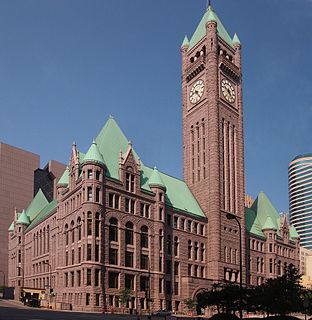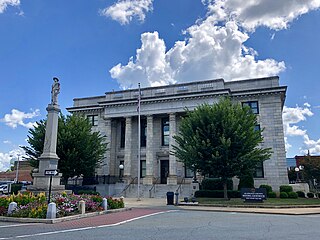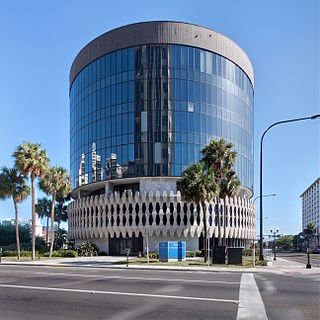
Orange is a town in, and county seat of, Orange County, Virginia. The population was 4,721 at the 2010 census, representing a 14.5% increase since the 2000 census. Orange is 28 miles (45 km) northeast of Charlottesville, 88 miles (142 km) southwest of Washington, D.C., and 4 miles (6 km) east of James Madison's plantation of Montpelier.

Theodore Robert Bundy was an American serial killer who kidnapped, raped, and murdered numerous young women and girls during the 1970s and possibly earlier. After more than a decade of denials, before his execution in 1989 he confessed to 30 homicides that he committed in seven states between 1974 and 1978. The true number of victims is believed to be higher.

Minneapolis City Hall and Hennepin County Courthouse, designed by Long and Kees in 1888, is the main building used by the city government of Minneapolis, Minnesota as well as by Hennepin County, Minnesota. The structure has served as mainly local government offices since it was built, and today the building is 60 percent occupied by the city and 40 percent occupied by the County. The building is jointly owned by the city and county and managed by the Municipal Building Commission. The Commission consists of the chair of the County Board, the mayor of the City of Minneapolis, a member of the County Board and a member of the Minneapolis City Council. The County Board chair serves as the president of the Commission and the mayor serves as the vice president. The building bears a striking resemblance to the city hall buildings in Cincinnati and Toronto. The City Hall and Courthouse was added to the National Register of Historic Places in 1974.

Downtown Orlando is the historic core and central business district of Orlando, Florida, United States. It is bordered by Marks Street in the north, Mills Avenue in the east, Orange Blossom Trail in the west, and Kaley Avenue in the south. There are several distinct neighborhoods in downtown; "North Quarter" to the north, "Lake Eola Heights Historic District" just north of Lake Eola, "South Eola" contains Lake Eola Park and continues to the east and south of Lake Eola, "Thornton Park" in the east, "Parramore" in the west, "Lake Cherokee Historic District" to the south, and the "Central Business District" between Colonial Drive and Lake Lucerne in the center. In 2010, the estimated population of downtown was 18,731. The daytime population was estimated to be 65,000. The 5-mile radius population of downtown is 273,335.
The history of Tallahassee, like the history of Leon County, begins with the Native American population and its interaction with British and Spanish colonists as well as colonial Americans and fugitive slaves, as the Florida Territory moved toward statehood. Growing numbers of cotton plantations increased the settlement's population greatly. It became a city and capital in 1821.

The 1841 Goshen Courthouse is located along Main Street in the center of Goshen, New York, the seat of Orange County, New York, United States. It was designed by popular local architect Thornton Niven in a Greek Revival style, meant to be a twin of the one he had already built in Newburgh, which at that time shared seat duties with the larger city. Construction of the building was approved by the county legislature in April 1841 and began shortly thereafter.

The Orange County Regional History Center is a private non-profit history museum located in downtown Orlando, Florida, United States. Located in the historic Orange County Courthouse, the five-story museum consists of exhibits presenting local and regional history starting from 12,000 years ago.
The Historical Society of Central Florida, formerly the Orange County Historical Society, is a historical society located in Orlando, Florida, United States. Located at the Orange County Regional History Center in the old Orange County Courthouse, the Historical Society collects and preserves the regional history of Central Florida.

The Orange County Courthouse, located in Orlando, Florida, United States, comprises the Ninth Judicial Circuit Court of Florida and its associated offices, including Orange County's County Court. The courthouse complex includes a 23-level courthouse tower, two five-story office buildings for the State Attorney and Public Defender, and a 1,500 car parking facility." It is connected to other downtown points by the free Lymmo bus.

The Abbeville County Courthouse, built in 1908, is an historic courthouse located in the east corner of Court Square, in the city of Abbeville in Abbeville County, South Carolina. It was designed in the Beaux Arts style by Darlington native William Augustus Edwards who designed several other South Carolina courthouses as well as academic buildings at 12 institutions in Florida, Georgia and South Carolina. An arcade connects it to the adjoining Abbeville Opera House and Municipal Center, which Edwards also designed. In 1964, the courthouse was renovated by Lyles, Bissett, Carlisle, and Wolff of Columbia. On October 30, 1981, it was added to the National Register of Historic Places. It is included in the Abbeville Historic District.

The Duval County Courthouse is the local courthouse for Duval County, Florida. It houses courtrooms and judges from the Duval County and Fourth Judicial Circuit Courts. The new facility is located Downtown Jacksonville, Florida; it was built starting in 2009 and opened in 2012.

The Federal Reserve Bank of Chicago Detroit Branch Building is a bank building located at 160 West Fort Street in downtown Detroit, Michigan. It was listed on the National Register of Historic Places in 2008.

Dr. Phillips Center for the Performing Arts is a performing arts center in Downtown Orlando, Florida, United States. It replaced the Bob Carr Theater, originally opened as the Orlando Municipal Auditorium in 1927, as Orlando's main theater. The center's grand opening was held on November 6, 2014.
Howard Montalbert Reynolds, Sr. was an American architect practicing in Orlando, Florida in the 1920s. He designed gracefully proportioned, notable public buildings in the prevailing fashionable styles of the 1920s, including Mediterranean Revival, Colonial Revival, Spanish Colonial, Egyptian Revival, Art Deco and Art Moderne.

Murry S. King (1870–1927) was Florida's first registered architect, a noted American architect with a successful practice in Orlando, Florida, in the 1910s and 1920s.

The Alamance County Courthouse in Graham, North Carolina, was built in 1923. It was listed on the National Register of Historic Places in 1979.
G.A. Miller Inc also known as GA Miller Construction Co. was a Tampa, Florida construction company. The company built twenty Kress stores including in St. Petersburg, Florida; Lakeland, Florida; Tampa; Ybor City; Fort Myers; Daytona Beach; as well as in North and South Carolina; Georgia; Alabama; Spokane, Washington; and Billings, Montana. The company also constructed the Edwards Theater, the original Sarasota Herald building, and the Mira Mar Hotel.

The American Federal Building, also known as the American Federal Savings and Loan Building, the Coral Gables Building, and the Round Building, was an iconic seven-story office building in downtown Orlando, Florida. The bottom two floors, encircled with a cast concrete brise soleil comprise the original building, completed in 1963. The building's unique architecture and history have inspired efforts to preserve it from demolition.

The architecture of Jacksonville is a combination of historic and modern styles reflecting the city's early position as a regional center of business. According to the National Trust for Historic Preservation, there are more buildings built before 1967 in Jacksonville than any other city in Florida, but it is also important to note that few structures in the city center predate the Great Fire of 1901. Numerous buildings in the city have held state height records, dating as far back as 1902, and last holding a record in 1981.

The Angebilt Hotel is a hotel located in Orlando, Florida at 37 North Orange Avenue. Designed by architect Murray S. King, the 11-story building was built from 1921-1923 and opened on March 14, 1923. It was operated by Joseph Fenner Ange since the Angebilt's opening until May 1923 when he announced bankruptcy and left the hotel. But the next year it was sold at public auction and re-opened. Then on February 27, 1983 it suffered a fire on the top 2 floors and was closed for renovations. Today, the Angebilt is now offices with bars and retail on the ground floor.

















